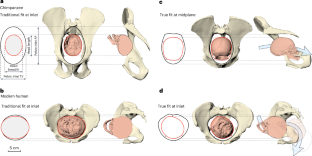重新评估黑猩猩的头盆适配性暗示产科限制在类人进化过程中逐渐加剧
IF 13.9
1区 生物学
Q1 ECOLOGY
引用次数: 0
摘要
根据产科困境假说,骨盆形状的性别二形性是适应胎儿骨盆高度约束的一种解决方案。因此,目前还不清楚为什么黑猩猩会表现出类似于人类的骨盆性二型模式,尽管它们的新生儿小且骨盆管宽敞,因而更容易分娩。在这里,我们利用三维模拟重新评估了黑猩猩的胎儿骨盆适应性,结果显示黑猩猩的中骨盆与人类相似,也是收缩的,出口尺寸甚至更窄。几何形态分析证实,尽管雌性黑猩猩体型较小,但其骨盆管道比雄性黑猩猩大,而且其形态最大化了有利于产仔的骨盆尺寸,尤其是在体型较小的个体中。与猴类相比,黑猩猩出生时神经系统更不成熟,我们的发现意味着黑猩猩和其他类人猿在产科方面受到很大限制。因此,我们提出,难产并不是随着脑化程度的提高而在智人中突然出现的,而是通过一系列产科方面的妥协而逐渐演化而来的。具体来说,我们认为,随着智人体型的增大,骨骺变硬,产道的选择压力逐渐增大,而随后对两足运动的适应又缩短了髂骨。由此造成的产道扭曲要求胎儿必须旋转,从而大大增加了出生难度。本文章由计算机程序翻译,如有差异,请以英文原文为准。


Gradual exacerbation of obstetric constraints during hominoid evolution implied by re-evaluation of cephalopelvic fit in chimpanzees
Under the obstetrical dilemma hypothesis, sexual dimorphism in pelvic shape is a solution to accommodate high fetopelvic constraints. It is therefore unclear why chimpanzees display a human-like pattern of pelvic sexual dimorphism despite having easier births enabled by small neonates and capacious pelvic canals. Here we reassessed chimpanzee fetopelvic fit using three-dimensional simulations, revealing a similarly constricted midpelvis as in humans, with even narrower outlet dimensions. Geometric morphometric analyses confirm that female chimpanzees have larger pelvic canals than males despite a smaller body size and a morphology that maximizes pelvic dimensions favourable for parturition, particularly in smaller-bodied individuals. Together with evidence for increased neurological immaturity at birth relative to monkeys, our findings imply substantial obstetric constraints in chimpanzees and possibly other apes. We therefore propose that difficult birth did not arise abruptly in Homo with increasing encephalization but evolved gradually through a series of obstetric compromises from an already constricted birth canal shared across anthropoid primates. Specifically, we propose that obstetric selection pressures exacerbated incrementally with the stiffening of the symphysis that accompanied body size increase in hominoids, while subsequent adaptations to bipedalism shortened the ilium. The resulting contorted birth canal required obligatory fetal rotation, thus greatly increasing birth difficulty. The ‘obstetrical dilemma’ hypothesis states that opposing selective pressures from an increased neonatal brain size and efficient bipedal locomotion constrain the birth canal in humans. However, three-dimensional simulations of chimpanzee fetopelvic fit indicate a constricted midpelvis comparable to humans, indicative of obstetric constraints that may be shared with apes thereby suggesting a gradual exacerbation of birth difficulty in hominoid evolution.
求助全文
通过发布文献求助,成功后即可免费获取论文全文。
去求助
来源期刊

Nature ecology & evolution
Agricultural and Biological Sciences-Ecology, Evolution, Behavior and Systematics
CiteScore
22.20
自引率
2.40%
发文量
282
期刊介绍:
Nature Ecology & Evolution is interested in the full spectrum of ecological and evolutionary biology, encompassing approaches at the molecular, organismal, population, community and ecosystem levels, as well as relevant parts of the social sciences. Nature Ecology & Evolution provides a place where all researchers and policymakers interested in all aspects of life's diversity can come together to learn about the most accomplished and significant advances in the field and to discuss topical issues. An online-only monthly journal, our broad scope ensures that the research published reaches the widest possible audience of scientists.
 求助内容:
求助内容: 应助结果提醒方式:
应助结果提醒方式:


